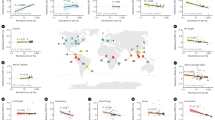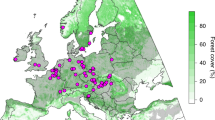Abstract
Two hypotheses to explain potentially high forest biodiversity have different implications for the number and kinds of species that can coexist and the potential loss of biodiversity in the absence of speciation. The first hypothesis involves stabilizing mechanisms, which include tradeoffs between species in terms of their capacities to disperse to sites where competition is weak1,2,3,4, to exploit abundant resources effectively5,6 and to compete for scarce resources7. Stabilization results because competitors thrive at different times and places. An alternative, ‘neutral model’ suggests that stabilizing mechanisms may be superfluous. This explanation emphasizes ‘equalizing’ mechanisms8, because competitive exclusion of similar species is slow. Lack of ecologically relevant differences means that abundances experience random ‘neutral drift’, with slow extinction9,10,11. The relative importance of these two mechanisms is unknown, because assumptions and predictions involve broad temporal and spatial scales. Here we demonstrate that predictions of neutral drift are testable using palaeodata. The results demonstrate strong stabilizing forces. By contrast with the neutral prediction of increasing variance among sites over time, we show that variances in post-Glacial tree abundances among sites stabilize rapidly, and abundances remain coherent over broad geographical scales.
This is a preview of subscription content, access via your institution
Access options
Subscribe to this journal
Receive 51 print issues and online access
$199.00 per year
only $3.90 per issue
Buy this article
- Purchase on Springer Link
- Instant access to full article PDF
Prices may be subject to local taxes which are calculated during checkout


Similar content being viewed by others
References
Horn, H. S. & MacArthur, R. H. Competition among fugitive species in a harlequin environment. Ecology 53, 749–752 (1972)
Hastings, A. Disturbance, coexistence, history, and competition for space. Theor. Pop. Biol. 18, 363–373 (1980)
Tilman, D. Competition and biodiversity in spatially structured habitats. Ecology 75, 2–16 (1994)
Hixon, M. A., Pacala, S. W. & Sandin, S. A. Population regulation: historical context and contemporary challenges of open vs. closed systems. Ecology 83, 1490–1508 (2002)
Pacala, S. W. & Rees, M. Field experiments that test alternative hypotheses explaining successional diversity. Am. Nat. 152, 729–737 (1998)
Bolker, B. M. & Pacala, S. W. Spatial moment equations for plant competition: understanding spatial strategies and the advantage of short dispersal. Am. Nat. 153, 575–602 (1999)
Tilman, D. Plant Strategies and the Dynamics and Structure of Plant Communities (Princeton Univ. Press, Princeton, New Jersey, 1998)
Chesson, P. Mechanisms of maintenance of species diversity. Annu. Rev. Ecol. Syst. 31, 343–366 (2000)
Hubbell, S. P. & Foster, R. B. in Community Ecology (eds Diamond, J. & Case, T. J.) 314–330 (Harper and Row, New York, New York, 1986)
Hubbell, S. P. et al. Light gap disturbances, recruitment limitation and tree diversity in a neotropical forest. Science 283, 554–557 (1999)
Hubbell, S. P. The Unified Neutral Theory of Biodiversity and Biogeography (Princeton Univ. Press, Princeton, New Jersey, 2001)
Clark, J. S., Dietze, M., Ibanez, I. & Mohan, J. Coexistence: how to discriminate trophic tradeoffs from slow dynamics. Ecology (in the press)
Huston, M. & Smith, T. Plant succession: life history and competition. Am. Nat. 130, 168–198 (1987)
Rees, M., Condit, R., Crawley, M., Pacala, S. & Tilman, D. Long term studies of vegetation dynamics. Science 293, 650–655 (2001)
Clark, J. S., LaDeau, S. & Ibanez, I. Fecundity of trees and the colonization–competition hypothesis Ecological Monog. (in the press).
Dickey, D. A. & Fuller, W. A. Distribution of the estimators for autoregressive time series with a unit root. J. Am. Stat. Assoc. 74, 427–431 (1979)
Jacobson, G. L. & Bradshaw, R. H. W. The selection sites for paleovetational studies. Quat. Res. 16, 80–96 (1981)
Prentice, I. C. Pollen representation, source area, and basin size: toward a unified theory of pollen analysis. Quat. Res. 23, 76–86 (1985)
Allison, T. D., Moeller, R. E. & Davis, M. B. Pollen in laminated sediments provides evidence for a mid-Holocene forest pathogen outbreak. Ecology 67, 1101–1105 (1986)
Bennett, K. D. & Fuller, J. L. Determining the age of the mid-Holocene Tsuga canadensis (hemlock) decline in eastern North America. Holocene 12, 421–429 (2002)
Huntley, B. & Birks, H. J. B. An Atlas of Past and Present Pollen Maps for Europe 0–13,000 Years Ago (Cambridge Univ. Press, New York, 1983)
Jackson, S. T., Overpeck, J. T., Webb, T., Keattch, S. E. & Anderson, K. H. Mapped plant-macrofossil and pollen records of late Quaternary vegetation change in eastern North America. Quat. Sci. Rev. 16, 1–70 (1997)
Bush, M. B., Miller, M. B., De Oliveira, P. E. & Colinvaux, P. A. Two histories of environmental change and human disturbance in eastern lowland Amazonia. Holocene 10, 543–553 (2000)
Dennis, B. & Taper, M. L. Density dependence in time series observations of natural populations: estimation and testing. Ecol. Monogr. 64, 205–224
Bennett, K. D. Holocene history of forest trees in southern Ontario. Can. J. Bot. 65, 1792–1801 (1987)
Burden, E. T., McAndrews, J. H. & Norris, G. Palynology of Indian and European forest clearance and farming in lake sediment cores from Awenda Provincial Park, Ontario. Can. J. Earth Sci. 23, 43–54 (1986)
Fuller, J. L. Holocene forest dynamics in southern Ontario, Canada: fine-resolution pollen data. Can. J. Bot. 75, 1714–1727 (1997)
McAndrews, J. H. & Campbell, I. D. in Proxy Climate Data and Models of the Six Thousand Years Before Present Time Interval: The Canadian Perspective (ed. Telka, A.) (Canadian Global Change Program Incidental Rep. Series IR93-3, The Royal Society of Canada, Ottawa, 1993)
Szeicz, J. M. & MacDonald, G. M. Postglacial vegetation history of oak savanna in southern Ontario. Can. J. Bot. 69, 1507–1519 (1991)
Acknowledgements
Research was supported by the National Science Foundation. We thank K. Bennett and P. Chesson for comments.
Author information
Authors and Affiliations
Corresponding author
Ethics declarations
Competing interests
The authors declare that they have no competing financial interests.
Rights and permissions
About this article
Cite this article
Clark, J., McLachlan, J. Stability of forest biodiversity. Nature 423, 635–638 (2003). https://doi.org/10.1038/nature01632
Received:
Accepted:
Issue Date:
DOI: https://doi.org/10.1038/nature01632
This article is cited by
-
Plant community and climate differ between former islands and submerged hills by proglacial lake Ojibway in eastern boreal Canada
Biodiversity and Conservation (2023)
-
Taxonomically and Functionally Distinct Ciliophora Assemblages Inhabiting Baltic Sea Ice
Microbial Ecology (2022)
-
Neutral syndrome
Nature Human Behaviour (2020)
-
Forest biodiversity, relationships to structural and functional attributes, and stability in New England forests
Forest Ecosystems (2018)
-
Natural regeneration of the herbaceous community in a semiarid region in Northeastern Brazil
Environmental Monitoring and Assessment (2013)
Comments
By submitting a comment you agree to abide by our Terms and Community Guidelines. If you find something abusive or that does not comply with our terms or guidelines please flag it as inappropriate.



